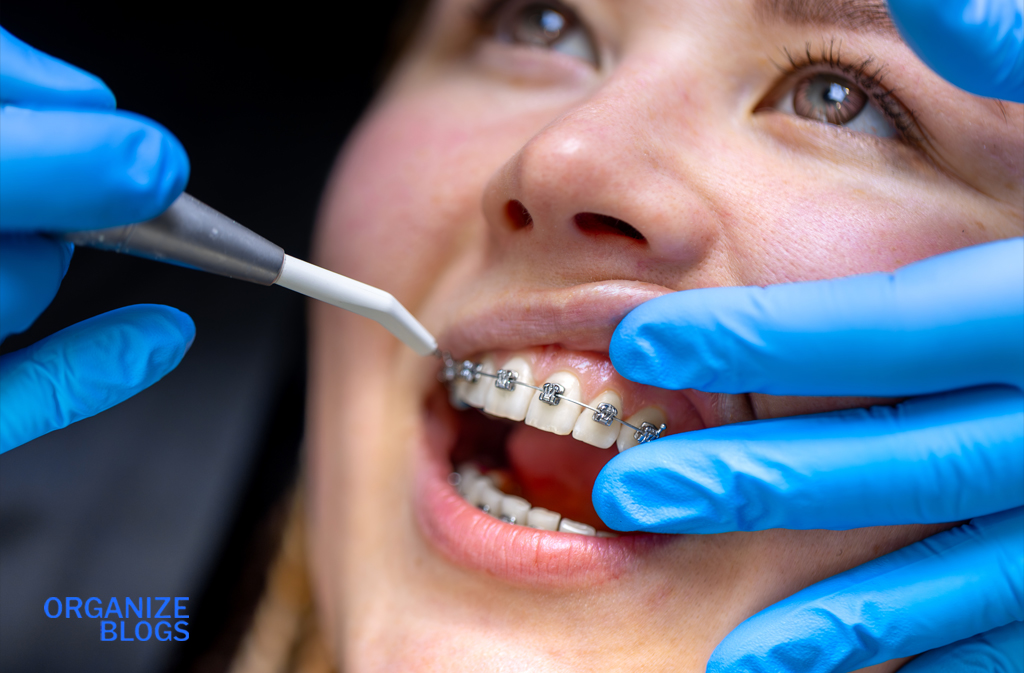Ceramic braces are a popular choice for people who want to straighten their teeth without the look of traditional metal braces. Made from a tooth-colored ceramic material, these braces blend in with your teeth, making them less noticeable. Because of their appearance and effectiveness, many people choose ceramic over silver brackets and wires.
In this guide, we’ll explain everything you need to know about ceramic braces, from cost and care tips to how they compare with other orthodontic options like aligners or metal braces. Whether you are thinking about getting braces for yourself or your child, this information will help you make the right choice.
Table of Contents
What Are Ceramic Braces?
Ceramic braces work just like traditional metal braces but use tooth-colored or clear ceramic brackets instead of shiny silver ones. These brackets hold the wire in place and are connected with elastic bands. Because they are less visible, they are often chosen by teens and adults who want a more discreet orthodontic treatment.
The ceramic material used in these braces is strong, but it can be more likely to break than metal braces. While they still move teeth effectively, the brackets are often larger than metal, which means you’ll need to brush and floss carefully to keep your teeth and gums healthy.
Why Choose Ceramic Braces Over Metal Braces?
One reason people choose ceramic braces is their appearance. Since they are tooth-colored, they blend in naturally with your smile. In contrast, traditional metal braces use silver brackets and wires, which are much easier to see.
Another reason is comfort. Many patients feel that ceramic brackets are smoother and less irritating to the inside of the mouth. While the length of treatment is usually the same—sometimes up to 36 months to straighten your teeth—many are willing to wear braces longer if they look more attractive.
How They Work to Straighten Teeth
Just like metal braces, ceramic braces use brackets, wires, and elastic bands to adjust the position of the teeth over time. The brackets hold the wire, which applies gentle pressure to shift teeth into their correct place.
You will need to visit your orthodontist regularly to adjust the wire and elastic bands. Over time, these small adjustments gradually move the teeth into the desired position. Although the process can take months or years, it is effective for fixing a wide range of dental issues.
Comparing Clear Braces and Metal Braces
When deciding between ceramic braces and traditional metal braces, there are several factors to consider. Metal braces are generally stronger and less likely to break. Ceramic brackets, however, offer a more attractive, tooth-colored look that appeals to many patients.
While metal braces are often less expensive, ceramic braces may be worth the extra cost for those who value appearance. The length of treatment is similar, but braces may require a bit more care to avoid staining from foods and drinks like coffee, tea, or red wine.
Cost and Insurance Coverage
The cost of ceramic braces can vary depending on your location, orthodontist, and treatment needs. On average, they are more expensive than metal braces. This is because the ceramic material and tooth-colored parts are more costly to produce.
Dental insurance may help cover part of the cost, but you should check with your provider to see what’s included. Even though they cost more, many people feel the investment is worth it for a better appearance during orthodontic treatment.

How Long Does Treatment With Braces Take?
The length of treatment for ceramic braces depends on your dental needs. For mild alignment issues, treatment can be completed in as little as 18 months. However, for more complex cases, it can take up to 36 months to straighten your teeth.
Regular orthodontic visits and following care instructions will help keep your treatment on track. Skipping appointments or breaking brackets can extend the time needed to achieve your perfect smile.
Caring for Ceramic Braces
Taking care of ceramic braces is important to avoid damage and staining. Since the brackets are tooth-colored, they can pick up color from certain foods and drinks. To keep them looking their best, try to limit coffee, tea, curry, and dark sodas.
It’s also important to brush and floss daily. Food can get stuck around the brackets and wires, so keeping your teeth clean will help prevent decay and gum problems. Using special flossing tools or a water flosser can make cleaning easier.
Common Issues With Ceramic Braces
While ceramic braces are effective, there are some things to keep in mind. The brackets can be more fragile than metal ones, so you should avoid biting into hard foods like nuts or ice.
They may also require more care to avoid staining. Even though the ceramic material itself does not stain easily, the elastic bands can discolor over time, making your braces more visible. Your orthodontist will replace these bands during your check-ups.
Ceramic Braces vs. Clear Aligners Like Invisalign
Many people wonder whether ceramic braces or clear aligners like Invisalign are better. The answer depends on your needs. Ceramic braces are fixed in place, so they work continuously and are good for more complex dental problems.
Clear aligners are removable, making them easier to clean and more convenient for eating. However, they must be worn for most of the day to be effective. If you want a treatment that doesn’t rely on daily discipline, ceramic braces might be the better choice.
Are Right for You?
If you want to straighten your teeth but dislike the look of metal braces, ceramic braces could be a great option. They work well for most orthodontic issues and offer a more natural appearance during treatment.
However, they do require extra care and may cost more than metal braces. Talking to your orthodontist will help you understand whether ceramic braces are the right choice for your lifestyle and budget.
Final Thoughts
In conclusion, ceramic braces are a modern alternative to traditional metal braces. They combine effectiveness with a discreet, tooth-colored design that many patients prefer. While they may be more expensive and require careful maintenance, their aesthetic benefits often make them worth the investment.
Whether you choose metal braces, ceramic braces, or aligners, the goal is the same—to adjust the position of the teeth and create a healthy, confident smile. With proper care and commitment, ceramic braces can give you excellent results and a smile you’ll love.

Frequently Asked Questions (FAQs)
Q1: What are ceramic braces?
Ceramic braces are orthodontic devices made from tooth-colored or clear ceramic material. They work like traditional metal braces but are less noticeable, making them a popular choice for teens and adults.
Q2: Are braces more expensive than metal braces?
Yes, ceramic braces are usually more expensive than metal braces because of the materials used and their aesthetic design. However, many patients feel the appearance is worth the extra cost.
Q3: How long do braces take to straighten teeth?
The length of treatment varies depending on your dental needs. On average, it can take between 18 and 36 months to complete treatment.
Q4: Do braces break easily?
Ceramic brackets can be more fragile than metal ones, so it’s important to avoid biting into hard foods like nuts, ice, or hard candy.
Q5: Can braces stain?
The ceramic material does not stain easily, but the elastic bands that hold the wire can discolor from certain foods and drinks like coffee, tea, and curry.
Visit our website: Organize Blogs

